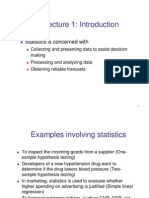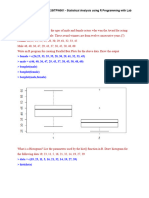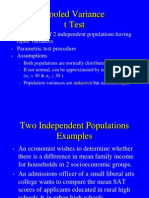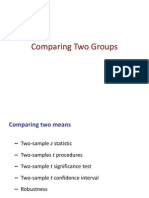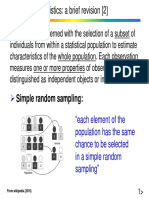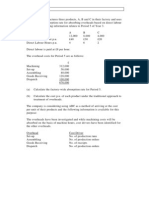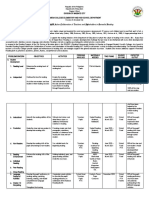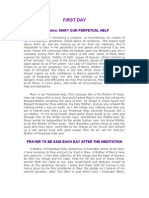Quantitative Analysis: Dr. Basheer Ahmad Samim
Quantitative Analysis: Dr. Basheer Ahmad Samim
Uploaded by
Erum AnwerCopyright:
Available Formats
Quantitative Analysis: Dr. Basheer Ahmad Samim
Quantitative Analysis: Dr. Basheer Ahmad Samim
Uploaded by
Erum AnwerOriginal Description:
Original Title
Copyright
Available Formats
Share this document
Did you find this document useful?
Is this content inappropriate?
Copyright:
Available Formats
Quantitative Analysis: Dr. Basheer Ahmad Samim
Quantitative Analysis: Dr. Basheer Ahmad Samim
Uploaded by
Erum AnwerCopyright:
Available Formats
Quantitative
Analysis
Dr. Basheer Ahmad Samim
1 10:28 AM
Recommended Readings (Books)
Introduction to Statistics, Walpole, R.
E., 3rd Edition (2000)
Statistical Methods for Practice and
Research by Ajai S. Gaur and Sanjaya S.
Gaur
Statistical Inference, Cassella, G. and
Berger, R. L., 2nd Edition (2002)
2 10:28 AM
Attendance Policy
8-Weeks Teaching
16-Lectures (32-Attendance)
Twice Roll Call, Once before the break
and once after the break
At Least 80% (24) Attendance is
compulsory to be elligible for the Final
Examination
No Roll Call after First Five(5) minutes
3 10:28 AM
Mode of Teaching
Lecture
SPSS Workshop
Discussion Session
4 10:28 AM
Mode of Assessment
Quizes (15%)
Assignments (15%)
Class Performance (5%)
Mid Term Test (25%)
Final Examination (40%)
5 10:28 AM
Questionnaire
6 10:28 AM
Introduction
to
Statistics
7 10:28 AM
Constant
A characteristic or
property that does not
change from individual
to individual.
8 10:28 AM
Variable
A characteristic or
property that varies
from individual to
individual.
9 10:28 AM
Types of Variable
10 10:28 AM
Types of
Variables
Qualitative
Nominal Ordinal
Quantitative
Discrete Continuous
Nominal Scale
Variable categories are mutually
exclusive and exhaustive.
Variable categories have no
logical order.
Eye Color, Hair Color, Gender.
11 10:28 AM
Ordinal Scale
Data categories are mutually
exclusive and exhaustive.
Data classifications are ranked or
ordered according to the
particular trait they possess.
Level of Knowledge about SPSS
12 10:28 AM
Interval Scale
Data categories are mutually exclusive
and exhaustive.
Data classifications are ranked or ordered
according to the particular trait they
possess.
Equal differences in the characteristic are
not represented by equal differences in
the measurements.
Temperature, Shoe Size and IQ scores
13 10:28 AM
14
Ratio Scale
Data categories are mutually exclusive and
exhaustive.
Data classifications are ranked or ordered
according to the particular trait they possess.
Equal differences in the characteristic are
represented by equal differences in the
measurements.
The zero point is the essence of the
characteristic.
Height, Weight, Distance.
10:28 AM
15
Scale
Nominal
Data may only
be classified
Eye color,
Hair Color
Gender.
Ordinal
Data are
ranked
Level of
Knowledge
about
SPSS
Interval
True Zero Point
does not
Exist.
Temperature,
Shoe Size,
IQ Scores
Ratio
Meaningful Zero
point and Ratio
Between values
Height, Weight,
Distance.
Measurement Scales
10:28 AM
16
Data
The information collected
for any kind of investigation.
Usually Numerical but can
be Qualitative.
10:28 AM
17
Primary Data
The initial material collected
during the research process.
The information collected
directly from the respondent.
Personal Invetigation, Through Investigator, Through Questionnaire,
Through Local Sources, Through Telephone,
10:28 AM
18
Secondary Data
The information
collected and processed
by the people other than
the researcher
Government Organizations, Semi-Government
Organizations,
10:28 AM
Data Collection
Any of the following methods may be
adopted:
(a) Personal interview
(b) Direct observation
(c) Mail interview (internet interview)
(d) Telephone interview
What are the cons and pros of each?
19 10:28 AM
Data management
Office Editing,
Post Coding,
Data entry and Verification.
20 10:28 AM
Data organization and Analysis
Preparing data for analysis,
Extracting descriptive measures
from the data,
Using advanced statistical
techniques to analyze the data
and draw inference there from.
21 10:28 AM
Summation
Notation
10:28 AM 22
Frequency
Distribution
10:28 AM 23
Cross
Tabulation
10:28 AM 24
25
Measures of Central Tendency
Arithmetic Mean
Quantiles
(Median, Quartiles, Deciles, Percentiles)
Mode
10:28 AM
26
Arithmetic Mean
A value obtained by dividing the sum of all the observations by
their number.
n n
X X X
X
n
1 i
i
n 2 1
X
=
=
+ + +
=
If X
1
, X
2
, , X
n
are n observations of a variable X then
ns observatio the of Number
ns observatio the all of Sum
Mean Arithmetic =
10:28 AM
27
Arithmetic Mean
The marks obtained by 8 students are:
Marks 5 . 68
8
548
8
63 72 67
X = =
+ + +
=
67 72 68 70 65 68 75 63
10:28 AM
28
Quantiles
For individual observations/discrete frequency
distribution, the ith quartile, jth decile and kth
percentile are located in the array/discrete frequency
distribution by the following relations
3 2, 1, i on, distributi in the n observatio th
4
1) i(n
Q
i
=
+
=
,9 2, 1, j on, distributi in the n observatio th
10
1) j(n
D
j
=
+
=
,99 2, 1, k on, distributi in the n observatio th
100
1) k(n
P
k
=
+
=
10:28 AM
29
The weekly TV Watching times (Hours):
25 41 27 32 43 66 35 31 15 5
34 26 32 38 16 30 38 30 20 21
Quartiles
The array of the above data is given below:
5 15 16 20 21 25 26 27 30 30
31 32 32 34 35 37 38 41 43 66
10:28 AM
30
Quartiles
Hours 22.0 21} - 0.25{25 21
obs.} 5th - obs. 0.25{6th obs. th 5
on distributi in the n observatio th 25 . 5
on distributi in the n observatio th
4
1) 1(20
Q
1
= + =
+ =
=
+
=
10:28 AM
31
Hours 30.5 30} - 0.50{31 30
obs.} 10th - obs. 0.50{11th obs. th 10
on distributi in the n observatio th 50 . 10
on distributi in the n observatio th
4
1) 2(20
Q
2
= + =
+ =
=
+
=
Quartiles
10:28 AM
32
Quantiles
10:28 AM
33
Mode
The mode is a value which occurs
most frequently in a set of data. Or
mode is a value that occurs
maximum number of times in a
sequence of observations.
10:28 AM
34
The total automobile sales (in millions) in
the United States for the last 14 years.
9.0 8.2 8.0 9.1 10.3 11.0 11.5
10.3 10.5 9.8 9.3 8.2 8.2 8.5
Mode
Mode = 8.2 million
10:28 AM
35
Measures of variation measure the
variation present among the values
of a data set, so measures of
variation are measures of spread of
values in the data.
10:28 AM
36
Absolute Measures of
Dispersion
Range
Quartile Deviation
Mean (Average) Deviation
Variance and Standard Deviation
10:28 AM
37
Relative Measures of
Dispersion
Coefficient of Range
Coefficient of Quartile Deviation
Coefficient of Mean Deviation
Coefficient of Variation (CV)
10:28 AM
38
Range
Difference between the largest
and the smallest observations
Largest Smallest
Range X X =
10:28 AM
39
Ignores the way in which data are distributed
Sensitive to outliers
7 8 9 10 11 12
Range = 12 - 7 = 5
7 8 9 10 11 12
Range = 12 - 7 = 5
Disadvantages of the Range
1,1,1,1,1,1,1,1,1,1,1,2,2,2,2,2,2,2,2,3,3,3,3,4,5
1,1,1,1,1,1,1,1,1,1,1,2,2,2,2,2,2,2,2,3,3,3,3,4,120
Range = 5 - 1 = 4
Range = 120 - 1 = 119
10:28 AM
Inter-quartile Range (IQR)
Inter-quartile range = 3
rd
quartile 1
st
Quartile
Q3 - Q1
IQR is independent of outliers
40 10:28 AM
Inter-quartile Range
41
Median
(Q2)
X
maximum
X
minimum
Q1 Q3
25% 25% 25% 25%
12 30 45 57 70
Inter-quartile Range (IQR)
= 57 30 = 27
10:28 AM
42
The Mean (absolute) Deviation
X
8 3
5 0
2 -3
0
Mean Deviation is the average of absolute
deviations taken form the mean value.
( )
6
2
3
x x
n
= =
3
0
3
6
( ) X X
X X
10:28 AM
43
Variance
Variance is the average
of the squared
deviations taken from
the mean value.
X cm (X-Mean)^2 X
2
4 36 16
6 16 36
9 1 81
12 4 144
13 9 169
16 36 256
60 102 702
2
2 2
2
2 2
2 2
( )
102
( ) 17
6
702 102
( ) 17
6 6
x x
i S cm
n
X X
ii S cm
n n
= = =
| |
| |
= = =
|
|
|
\ .
\ .
10:28 AM
44
Comparing Standard Deviations
Mean = 15.5
S = 3.338
11 12 13 14 15 16 17 18 19 20 21
Data A
11 12 13 14 15 16 17 18 19 20 21
Mean = 15.5
S = 4.567
Data C
The smaller the standard deviation, the more tightly
clustered the scores around mean
The larger the standard deviation, the more spread out
the scores from mean
10:28 AM
11 12 13 14 15 16 17 18 19 20 21
Data B
Mean = 15.5
S = 0.926
45
Relative Measures of Variation
Largest Smallest
Largest Smallest
Coefficient of Range
X X
X X
=
+
3 1
3 1
Coefficient of Quartile Deviation
Q Q
Q Q
=
+
Coefficient of Mean Deviation
MD
Mean
=
10:28 AM
Coefficient of Variation (CV)
Can be used to compare two or more
sets of data measured in different
units or same units but different
average size.
10:28 AM 46
100%
X
S
CV
|
|
.
|
\
|
=
47
Use of Coefficient of Variation
Stock A:
Average price last year = $50
Standard deviation = $5
Stock B:
Average price last year = $100
Standard deviation = $5
but stock B is
less variable
relative to its
price
10% 100%
$50
$5
100%
X
S
CV
A
= =
|
|
.
|
\
|
=
5% 100%
$100
$5
100%
X
S
CV
B
= =
|
|
.
|
\
|
=
Both stocks
have the
same
standard
deviation
10:28 AM
48
Appropriate Choice of Measure
of Variability
If data are symmetric, with no serious
outliers, use range and standard
deviation.
If data are skewed, and/or have serious
outliers, use IQR.
If comparing variation across two data
sets, use coefficient of variation (C.V)
10:28 AM
49
Five Number Summary
The five number summary of a data set consists of the
minimum value, the first quartile, the second quartile, the
third quartile and the maximum value written in that order:
Min, Q
1
, Q
2
, Q
3
, Max.
From the three quartiles we can obtain a measure of central
tendency (the median, Q
2
) and measures of variation of the
two middle quarters of the distribution, Q
2
-Q
1
for the
second quarter and Q
3
-Q
2
for the third quarter.
10:28 AM
50
The weekly TV viewing times (in hours).
25 41 27 32 43 66 35 31 15 5
34 26 32 38 16 30 38 30 20 21
The array of the above data is given below:
5 15 16 20 21 25 26 27 30 30
31 32 32 34 35 37 38 41 43 66
Five Number Summary
10:28 AM
51
Hrs 22.0 21} - 0.25{25 21 obs.} 5th - obs. 0.25{6th obs. 5th ; Q1 of VALUE
obs. 5.25th data in the obs. th
4
1) 1(20
; Q1 of LOCATION
= + = +
=
+
Five Number Summary
Hrs 30.5 30} - 0.50{31 0 3 obs.} 10th - obs. 0.50{11th obs. th 10 ; Q2 of VALUE
obs. th 50 . 10 data in the obs. th
4
1) 2(20
;
2
Q of LOCATION
= + = +
=
+
Minimum value=5.0 Maximum value=66.0
Hrs 36.5 35} - 0.75{37 35 obs} 15th - obs {16th 75 . 0 obs 15th ;
3
Q of VALUE
obs. 15.75th data in the obs. th
4
1) 3(20
;
3
Q of LOCATION
= + = +
=
+
10:28 AM
52
Box and Whisker Diagram
A box and whisker diagram or box-plot is a
graphical mean for displaying the five number
summary of a set of data. In a box-plot the first
quartile is placed at the lower hinge and the
third quartile is placed at the upper hinge. The
median is placed in between these two hinges.
The two lines emanating from the box are
called whiskers. The box and whisker diagram
was introduced by Professor Jhon W. Tukey.
10:28 AM
53
Construction of Box-Plot
1. Start the box from Q1 and end at
Q3
2. Within the box draw a line to
represent Q2
3. Draw lower whisker to Min.
Value up to Q1
4. Draw upper Whisker from Q3 up
to Max. Value
Q1
Q3
Q2
10:28 AM
Max
Value
Min
Value
54
Construction of Box-Plot
1. Q1=22.0 Q3=36.5
2. Q2=30.5
3. Minimum Value=5.0
4. Maximum Value=66.0
70
60
50
40
30
20
10
0
10:28 AM
55
Interpretation of Box-Plot
70
60
50
40
30
20
10
0
Box-Whisker Plot is useful to identify
Maximum and Minimum Values in the data
Median of the data
IQR=Q3-Q1,
Lengthy box indicates more variability in the data
Shape of the data From Position of line within box
Line At the center of the box----Symmetrical
Line above center of the box----Negatively skewed
Line below center of the box----Positively Skewed
Detection of Outliers in the data
10:28 AM
56
Outliers
An outlier is the values that falls well outside the overall
pattern of the data. It might be
the result of a measurement or recording error,
a member from a different population,
simply an unusual extreme value.
An extreme value needs not to be an outliers; it might,
instead, be an indication of skewness.
10:28 AM
57
Inner and Outer Fences
If Q1=22.0 Q2=30.5 Q3=36.5
( )
( )
= + =
= =
25 . 58 IQR 1.5 Q Fence Inner Upper
25 . 0 IQR 1.5 Q Fence Inner Lower
: Fences Inner
3
1
( )
( )
= + =
= =
0 . 80 IQR 3 Q Fence Outer Upper
5 . 21 IQR 3 Q Fence Outer Lower
: Fences Outer
3
1
10:28 AM
58
Identification of the Outliers
1. The values that lie within inner
fences are normal values
2. The values that lie outside inner
fences but inside outer fences
are possible/suspected/mild
outliers
3. The values that lie outside outer
fences are sure outliers
80
70
60
50
40
30
20
10
0
Plot each suspected outliers with an asterisk
and each sure outliers with an hollow dot.
*
Only
66 is a
mild
outlier
10:28 AM
59
Box plots are
especially suitable for
comparing two or more
data sets. In such a
situation the box plots
are constructed on the
same scale.
Uses of Box and Whisker Diagram
Male
Female
10:28 AM
Standardized Variable
A variable that has mean 0 and Variance 1 is
called standardized variable
Values of standardized variable are called
standard scores
Values of standard variable i.e standard scores are
unit-less
Construction
Variable of Deviation Standard
Variable of Mean Variable
Z
=
10:28 AM 60
X Z
3 25 -1.3624 1.8561
6 4 -0.5450 0.2970
11 9 0.81741 0.6682
12 16 1.0899 1.1879
32 54 0 4.009
5 . 13
4
54
8
4
32
2
= =
= = =
x
S
n
X
X
2
) ( X X
67 . 3
8
=
=
X
Sx
X X
Z
1
4
009 . 4
0
2
~ =
= =
z
S
n
Z
Z
2
) ( Z Z
Variable Z has mean 0 and
variance 1 so Z is a standard variable.
Standard Score at X=11 is
8174 . 0
67 . 3
8 11
=
=
Sx
X X
Z
10:28 AM
Standardized Variable
62
The industry in which sales rep Mr. Atif works has mean
annual sales=$2,500
standard deviation=$500.
The industry in which sales rep Mr. Asad works has mean
annual sales=$4,800
standard deviation=$600.
Last year Mr. Atifs sales were $4,000 and
Mr. Asads sales were $6,000.
Performance evaluation by z-scores
Which of the representatives would you hire
if you have one sales position to fill?
10:28 AM
63
Performance evaluation by z-scores
3
500
500 , 2 000 , 4
=
=
B
B
B B
B
Z
S
X X
Z
Sales rep. Atif
X
B
= $2,500
S
B
= $500
X
B
= $4,000
Sales rep. Asad
X
P
=$4,800
S
P
= $600
X
P
= $6,000
2
600
800 , 4 000 , 6
=
=
P
P
P P
P
Z
S
X X
Z
Mr. Atif is the best choice
10:28 AM
64
values of 68.26% about contains 1S X
The Empirical Rule
X
68.26%
1S X
values of 99.73% about contains 3S X
values of 95.45% about contains 2S X
95.45%
X 2S
X 3S
99.73%
10:28 AM
65
A distribution in which the values equidistant from
the centre have equal frequencies is defined to be
symmetrical and any departure from symmetry is
called skewness.
1. Length of Right Tail = Length of Left
Tail
2. Mean = Median = Mode
3. Sk=0
a) Sk=(Mean-Mode)/SD
b) Sk=(Q3-2Q2+Q1)/(Q3-Q1)
10:28 AM
Measures of Skewness
66
A distribution is positively skewed, if the observations
tend to concentrate more at the lower end of the possible
values of the variable than the upper end. A positively
skewed frequency curve has a longer tail on the right
hand side
1. Length of Right Tail > Length of Left
Tail
2. Mean > Median > Mode
3. SK>0
Measures of Skewness
10:28 AM
67
A distribution is negatively skewed, if the
observations tend to concentrate more at the upper
end of the possible values of the variable than the
lower end. A negatively skewed frequency curve has a
longer tail on the left side.
1. Length of Right Tail < Length of Left
Tail
2. Mean < Median < Mode
3. SK< 0
10:28 AM
Measures of Skewness
10:28 AM 68
The Kurtosis is the degree of peakedness or flatness of a
unimodal (single humped) distribution,
When the values of a variable are highly concentrated around
the mode, the peak of the curve becomes relatively high; the
curve is Leptokurtic.
When the values of a variable have low concentration around
the mode, the peak of the curve becomes relatively flat;curve
is Platykurtic.
A curve, which is neither very peaked nor very flat-toped, it
is taken as a basis for comparison, is called
Mesokurtic/Normal.
Measures of Kurtosis
69 10:28 AM
Measures of Kurtosis
70
Measures of Kurtosis
1. If Coefficient of Kurtosis > 3 ----------------- Leptokurtic.
2. If Coefficient of Kurtosis = 3 ----------------- Mesokurtic.
3. If Coefficient of Kurtosis < 3 ----------------- is Platykurtic.
( )
( )
4
2
2
n X-X
Coefficient of Kurtosis=
X-X
(
10:28 AM
SPSS
Statistical Package
for Social Sciences
10:28 AM 71
You might also like
- Grave Coercion - JurisprudenceDocument6 pagesGrave Coercion - JurisprudenceBey Villanueva100% (1)
- English Laghu Parashari - O P VermaDocument187 pagesEnglish Laghu Parashari - O P Vermapushpane100% (10)
- Acc QMDocument15 pagesAcc QMTomoki HattoriNo ratings yet
- Chapter 1 Statistical Sleuth in RDocument10 pagesChapter 1 Statistical Sleuth in RCollin SandersonNo ratings yet
- Why Physicists Can't Avoid A Creation EventDocument2 pagesWhy Physicists Can't Avoid A Creation EventNobody Important100% (1)
- English For Academic and Professional Purposes: Quarter 1 - Module 3 Approaches in Literary CriticismDocument42 pagesEnglish For Academic and Professional Purposes: Quarter 1 - Module 3 Approaches in Literary CriticismMyst90% (49)
- Module 1 Statistical InferenceDocument67 pagesModule 1 Statistical InferencenrsiddiquiNo ratings yet
- Arm & Sa Spring 13Document64 pagesArm & Sa Spring 13Bilal Ahmed QureshiNo ratings yet
- Statistical InferenceDocument69 pagesStatistical InferenceMsKhan0078No ratings yet
- Lecture 1: Introduction: Statistics Is Concerned WithDocument45 pagesLecture 1: Introduction: Statistics Is Concerned WithWei CongNo ratings yet
- 2 Mean Median Mode VarianceDocument29 pages2 Mean Median Mode VarianceBonita Mdoda-ArmstrongNo ratings yet
- Descriptive StatisticsDocument18 pagesDescriptive StatisticsDiana HrabNo ratings yet
- Demand Forecasting InformationDocument66 pagesDemand Forecasting InformationAyush AgarwalNo ratings yet
- ECON1203/ECON2292 Business and Economic Statistics: Week 2Document10 pagesECON1203/ECON2292 Business and Economic Statistics: Week 2Jason PanNo ratings yet
- Principle of Biostatistic Marcello Pagano Principle & Method Richard A Jhonson & Gouri K. BhattacharyyaDocument45 pagesPrinciple of Biostatistic Marcello Pagano Principle & Method Richard A Jhonson & Gouri K. BhattacharyyaArdena Maulidia HamdaniNo ratings yet
- MBA -I QM QB UNIT 2Document23 pagesMBA -I QM QB UNIT 2baap4071No ratings yet
- Discriptive StatisticsDocument50 pagesDiscriptive StatisticsSwathi JanardhanNo ratings yet
- Unit 3_Unit 4 Problems and SolutionsDocument30 pagesUnit 3_Unit 4 Problems and SolutionsagashagshagashagshNo ratings yet
- Worksheets-Importance of MathematicsDocument38 pagesWorksheets-Importance of MathematicsHarsh VyasNo ratings yet
- Bus173 Chap03Document42 pagesBus173 Chap03KaziRafiNo ratings yet
- Basic 1Document60 pagesBasic 1Rajesh DwivediNo ratings yet
- Unit 1part2 DataAnalytics Asha Karegowda - NewDocument24 pagesUnit 1part2 DataAnalytics Asha Karegowda - NewPřïñçê Goutham MadivalaNo ratings yet
- 22Mitch-UncertaintiesinDosimetry 26Document53 pages22Mitch-UncertaintiesinDosimetry 26Pataki SandorNo ratings yet
- AGR003 Laboratory Stats Tester: For AndroidDocument3 pagesAGR003 Laboratory Stats Tester: For AndroidFrederick CabactulanNo ratings yet
- Measures of DispersionDocument59 pagesMeasures of DispersiontiffanyNo ratings yet
- Lec 1Document54 pagesLec 1Jayveer SinghNo ratings yet
- Determination of Effectiveness of Sa and Srs Methods On The Data Produced From Continuous DistributionsDocument5 pagesDetermination of Effectiveness of Sa and Srs Methods On The Data Produced From Continuous DistributionsHabib KoçakNo ratings yet
- Analysis of VarianceDocument62 pagesAnalysis of VarianceJohnasse Sebastian NavalNo ratings yet
- Stat 1101 4 7Document18 pagesStat 1101 4 7MD Abdul AlimNo ratings yet
- Unit 20 - Central Tendency and Dispersion (Student)Document13 pagesUnit 20 - Central Tendency and Dispersion (Student)Suresh MgNo ratings yet
- ANOVADocument82 pagesANOVAPradeepNo ratings yet
- Week 3 Parameters of A Frequency DistributionDocument36 pagesWeek 3 Parameters of A Frequency DistributionJuliana Alexis MalabadNo ratings yet
- StatisticsDocument27 pagesStatisticsJudy Mae Arenilla SudayNo ratings yet
- Unit - 3 (QM)Document11 pagesUnit - 3 (QM)DEEPTHI ANN JACOBNo ratings yet
- Midterm Review (Updated)Document74 pagesMidterm Review (Updated)helengao0428No ratings yet
- Stat Slides 5Document30 pagesStat Slides 5Naqeeb Ullah KhanNo ratings yet
- N S X T N X Z: 7.1 Inference For The Mean of A Population T DistributionsDocument25 pagesN S X T N X Z: 7.1 Inference For The Mean of A Population T DistributionsKit De AngelisNo ratings yet
- Ken Black QA ch03Document61 pagesKen Black QA ch03Rushabh Vora0% (1)
- By: David NegrelliDocument27 pagesBy: David NegrelliBliss ManNo ratings yet
- Mean Median ModeDocument56 pagesMean Median ModeJenneth Cabinto DalisanNo ratings yet
- Measure of Central TendencyDocument40 pagesMeasure of Central TendencybmNo ratings yet
- Measures of Central Tendency, Dispersion and ShapeDocument10 pagesMeasures of Central Tendency, Dispersion and Shapesiwaleniza42No ratings yet
- Dispersion (S)Document44 pagesDispersion (S)rawatpriyanka0909No ratings yet
- Regression With A Single Regressor: Hypothesis Tests and Confidence IntervalsDocument46 pagesRegression With A Single Regressor: Hypothesis Tests and Confidence IntervalsinebergmansNo ratings yet
- Comparing Two GroupsDocument25 pagesComparing Two GroupsJosh PotashNo ratings yet
- Descriptive Statistics: Numerical Descriptive Statistics: Numerical Methods Methods Methods MethodsDocument52 pagesDescriptive Statistics: Numerical Descriptive Statistics: Numerical Methods Methods Methods Methodsarshiya_21No ratings yet
- Ken Black QA ch10Document47 pagesKen Black QA ch10Rushabh VoraNo ratings yet
- 2 - Module 1 - Descriptive Statistics - Frequency Tables, Measure of Central Tendency & Measures of DispersionDocument21 pages2 - Module 1 - Descriptive Statistics - Frequency Tables, Measure of Central Tendency & Measures of DispersionsyazwanNo ratings yet
- Dr. Pham Huynh Tram Department of ISE Phtram@hcmiu - Edu.vnDocument37 pagesDr. Pham Huynh Tram Department of ISE Phtram@hcmiu - Edu.vnNgọc Nhung VũNo ratings yet
- Statistik IifDocument9 pagesStatistik IifMauidzotussyarifahNo ratings yet
- Bbs12e Onlinetopic Ch12-8Document7 pagesBbs12e Onlinetopic Ch12-8Boboho HeroNo ratings yet
- Numerical Descriptive MeasuresDocument52 pagesNumerical Descriptive MeasureschanlalNo ratings yet
- Statistic Sample Question IiswbmDocument15 pagesStatistic Sample Question IiswbmMudasarSNo ratings yet
- Numerical Measures: Bf1206-Business Mathematics SEMESTER 2 - 2016/2017Document25 pagesNumerical Measures: Bf1206-Business Mathematics SEMESTER 2 - 2016/2017Muhammad AsifNo ratings yet
- Statistics: A Brief Revision (2) : Simple Random SamplingDocument12 pagesStatistics: A Brief Revision (2) : Simple Random SamplingIzabelaBatistaNo ratings yet
- 04 Counting StatisitcsDocument30 pages04 Counting Statisitcsadelansari49No ratings yet
- Hypothesis Testing: DR James BettsDocument36 pagesHypothesis Testing: DR James BettsMei RyuzakiNo ratings yet
- Aem214 CH-3CDocument6 pagesAem214 CH-3CLucky GojeNo ratings yet
- Lectures 8 9 10Document185 pagesLectures 8 9 10AzmiHafifiNo ratings yet
- BusDocument18 pagesBusSudip SahaNo ratings yet
- Numerical Descriptive Measures 1Document39 pagesNumerical Descriptive Measures 1Dolores AbanganNo ratings yet
- Report On Nestle LassiDocument19 pagesReport On Nestle LassiErum AnwerNo ratings yet
- Calculations of Q 2&3-IIDocument1 pageCalculations of Q 2&3-IIErum AnwerNo ratings yet
- Report On Nestle LassiDocument19 pagesReport On Nestle LassiErum AnwerNo ratings yet
- Case Study Coca ColaDocument19 pagesCase Study Coca ColaErum AnwerNo ratings yet
- CM 4Document15 pagesCM 4Erum AnwerNo ratings yet
- CM 4Document15 pagesCM 4Erum AnwerNo ratings yet
- Capital (K) Labour (L) Total Product (TP) Average Product (AP) Marginal Product (MP)Document2 pagesCapital (K) Labour (L) Total Product (TP) Average Product (AP) Marginal Product (MP)Erum AnwerNo ratings yet
- Nestle Pakistan - HR ProjectDocument19 pagesNestle Pakistan - HR ProjectErum AnwerNo ratings yet
- BUDGET 2014-15 (Development Expenditure) : 1.1. Critical BackgroundDocument2 pagesBUDGET 2014-15 (Development Expenditure) : 1.1. Critical BackgroundErum AnwerNo ratings yet
- Explicit Cost Implicit Cost: Question # 03Document1 pageExplicit Cost Implicit Cost: Question # 03Erum AnwerNo ratings yet
- Pakistan Budget 2014-15Document3 pagesPakistan Budget 2014-15Erum AnwerNo ratings yet
- Question # 04 Jill's Accounting ProfitDocument1 pageQuestion # 04 Jill's Accounting ProfitErum AnwerNo ratings yet
- Chapter 13-Supply Chain Process Integration: Principles of Supply Chain Management: A Balanced ApproachDocument19 pagesChapter 13-Supply Chain Process Integration: Principles of Supply Chain Management: A Balanced ApproachErum Anwer100% (1)
- Nestle ProjectDocument27 pagesNestle ProjectErum AnwerNo ratings yet
- Project Document - Supply ChainDocument197 pagesProject Document - Supply Chainshab-i-tab78% (9)
- Managerial AccountingDocument23 pagesManagerial AccountingErum AnwerNo ratings yet
- Ratio Analysis: 15. Ratios at A GlanceDocument7 pagesRatio Analysis: 15. Ratios at A GlanceErum AnwerNo ratings yet
- Sale of GoodsDocument6 pagesSale of GoodsErum AnwerNo ratings yet
- Business StatisticsDocument69 pagesBusiness StatisticsErum AnwerNo ratings yet
- Analysis of Financial Statement: AFS ProjectDocument11 pagesAnalysis of Financial Statement: AFS ProjectErum AnwerNo ratings yet
- Recruitment and Selection in Bank AlfalahDocument17 pagesRecruitment and Selection in Bank AlfalahErum AnwerNo ratings yet
- Safety and Feasibility of A Neuroscience Critical Care Program To Mobilize Patients With Primary Intracerebral HemorrhageDocument23 pagesSafety and Feasibility of A Neuroscience Critical Care Program To Mobilize Patients With Primary Intracerebral HemorrhagePamela DíazNo ratings yet
- RTU500 Series Remote Terminal Unit: Protocol Description Bidirectional Communication Interface With IEC60870-5-104Document68 pagesRTU500 Series Remote Terminal Unit: Protocol Description Bidirectional Communication Interface With IEC60870-5-104Bruno Nemer TattonNo ratings yet
- What Is Globalization?: Variety of Definitions & Other TermsDocument17 pagesWhat Is Globalization?: Variety of Definitions & Other TermsMichalcova Realisan JezzaNo ratings yet
- Microeconomía - Capítulo 10Document15 pagesMicroeconomía - Capítulo 10Carlos García SandovalNo ratings yet
- The Psychological World of Natsume Sōseki.Document4 pagesThe Psychological World of Natsume Sōseki.zwslpoNo ratings yet
- Barrio Fiesta 2018: Gunita - The Recollections PROGRAMDocument37 pagesBarrio Fiesta 2018: Gunita - The Recollections PROGRAMHaydenNo ratings yet
- Love Is WickedDocument3 pagesLove Is WickedRumbidzai MapfumoNo ratings yet
- CIE - O Level - Physics Syllabus - 2020-2021Document40 pagesCIE - O Level - Physics Syllabus - 2020-2021astargroupNo ratings yet
- Mitos Dan Realiti PentaksiranDocument22 pagesMitos Dan Realiti PentaksiranNurhidayati Abd LatifNo ratings yet
- Project Act Starr Active Collaboration of Teachers and Stakeholders in Remedial ReadingDocument4 pagesProject Act Starr Active Collaboration of Teachers and Stakeholders in Remedial ReadingJeric Espinosa CabugNo ratings yet
- Copi The Burali-Forti ParadoxDocument7 pagesCopi The Burali-Forti ParadoxPhilippe GagnonNo ratings yet
- Novena To Mother of Perpetual HelpDocument2 pagesNovena To Mother of Perpetual Helpsweetm05No ratings yet
- Uniform Rules of CourtDocument38 pagesUniform Rules of Courttfarra1No ratings yet
- CognitiveDocument32 pagesCognitivePoonam RanaNo ratings yet
- Ncert History Notes-11 (03 Dec 2021)Document28 pagesNcert History Notes-11 (03 Dec 2021)pk031992No ratings yet
- A Tiger in The ZooDocument13 pagesA Tiger in The ZooSuryanshuNo ratings yet
- Coaching Conversation Script - Worry StaffDocument7 pagesCoaching Conversation Script - Worry StaffAdamNo ratings yet
- Extreme For Kids Vol 4 PDFDocument116 pagesExtreme For Kids Vol 4 PDFEverylNo ratings yet
- Embercombe Course Waking DragonsDocument19 pagesEmbercombe Course Waking DragonsWitchruna HaljarunaNo ratings yet
- Jurisprudence On Cedula and Personal Appearance Notary PublicDocument13 pagesJurisprudence On Cedula and Personal Appearance Notary Publicdorothy annNo ratings yet
- Metadichol and Type2 Diabetes A Case StudyDocument5 pagesMetadichol and Type2 Diabetes A Case StudyDr P.R. RaghavanNo ratings yet
- mp2 ReportDocument10 pagesmp2 Reportapi-287804971No ratings yet
- Brubaker 2001Document5 pagesBrubaker 2001Residencia OftalmologíaNo ratings yet
- Single Leg Stance Test 1Document1 pageSingle Leg Stance Test 1Miranti Ika RachmawatiNo ratings yet
- Culminating Narrative InternshipDocument2 pagesCulminating Narrative InternshipJose Schneider100% (1)
- Truck Body Mounting Directives 01-09-2006Document362 pagesTruck Body Mounting Directives 01-09-2006George JabbourNo ratings yet










